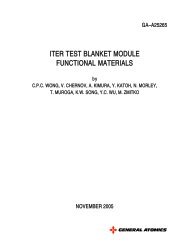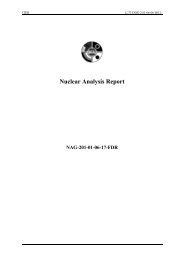iter structural design criteria for in-vessel components (sdc-ic)
iter structural design criteria for in-vessel components (sdc-ic)
iter structural design criteria for in-vessel components (sdc-ic)
Create successful ePaper yourself
Turn your PDF publications into a flip-book with our unique Google optimized e-Paper software.
ITER G 74 MA 8 01-05-28 W0.2<br />
relaxation, the sum of the <strong>in</strong>cremental elast<strong>ic</strong> stra<strong>in</strong> and <strong>in</strong>cremental irradiation-<strong>in</strong>duced creep<br />
stra<strong>in</strong> is zero, i.e.,<br />
e<br />
ij<br />
c<br />
ij<br />
eÇ + eÇ<br />
= 0 (1)<br />
If the material obeys the creep law given by Eq. 1 of B 3024.1.1.1, then denot<strong>in</strong>g the <strong>in</strong>itial<br />
and relaxed thermal stresses by so and s respectively, Eq. (1) can be solved as follows:<br />
<strong>for</strong> the uniaxial case,<br />
( )<br />
s = soexp -EB(<br />
T, f) ft<br />
(2)<br />
and <strong>for</strong> the equi-biaxial case,<br />
æ 3 EB( T, f) ftö<br />
sij = sodij expç<br />
-<br />
÷<br />
è 2 ( 1 - n)<br />
ø<br />
where i , j = 1,2<br />
and E and n are the Young's modulus and Poisson's ratio.<br />
If the material obeys a creep law different from Eq. (1) of B 3024.1.1.1 or if the <strong>in</strong>itial<br />
start<strong>in</strong>g stress is more general than equi-biaxial, Eq(1) can be solved numer<strong>ic</strong>ally if a closed<br />
<strong>for</strong>m solution cannot be obta<strong>in</strong>ed.<br />
B 3024.1.2 Neuber's rule<br />
Neuber's rule can be applied to estimate the maximum elasto-plast<strong>ic</strong> stresses and stra<strong>in</strong>s at<br />
notch roots. Consider a notch with an elast<strong>ic</strong> stress concentration factor KT subjected to a<br />
nom<strong>in</strong>al (remote) uniaxial stress So and, <strong>for</strong> a l<strong>in</strong>ear elast<strong>ic</strong> material, correspond<strong>in</strong>g remote<br />
uniaxial stra<strong>in</strong> eo (eo = So/E). The elast<strong>ic</strong>ally calculated peak stress (S) and stra<strong>in</strong> (e) at the<br />
notch root are given by<br />
S = KTSo<br />
e = KTeo<br />
NeuberÕs rule states that, if we replace the l<strong>in</strong>ear elast<strong>ic</strong> material with a material obey<strong>in</strong>g a<br />
uniaxial power-law constitutive equation,<br />
s = Ae n ,<br />
then, denot<strong>in</strong>g the notch root maximum stress and stra<strong>in</strong> by s and e,<br />
s · e = S · e (1)<br />
The above equations can be solved <strong>for</strong> the maximum stress and stra<strong>in</strong> at the notch roots as<br />
s = SK<br />
e = eK<br />
2n/( 1+<br />
n)<br />
o T<br />
2/( 1+<br />
n)<br />
o T<br />
SDC-IC, Appendix B. Guidel<strong>in</strong>es <strong>for</strong> Analysis page 26<br />
(3)<br />
(2a)<br />
(2b)




